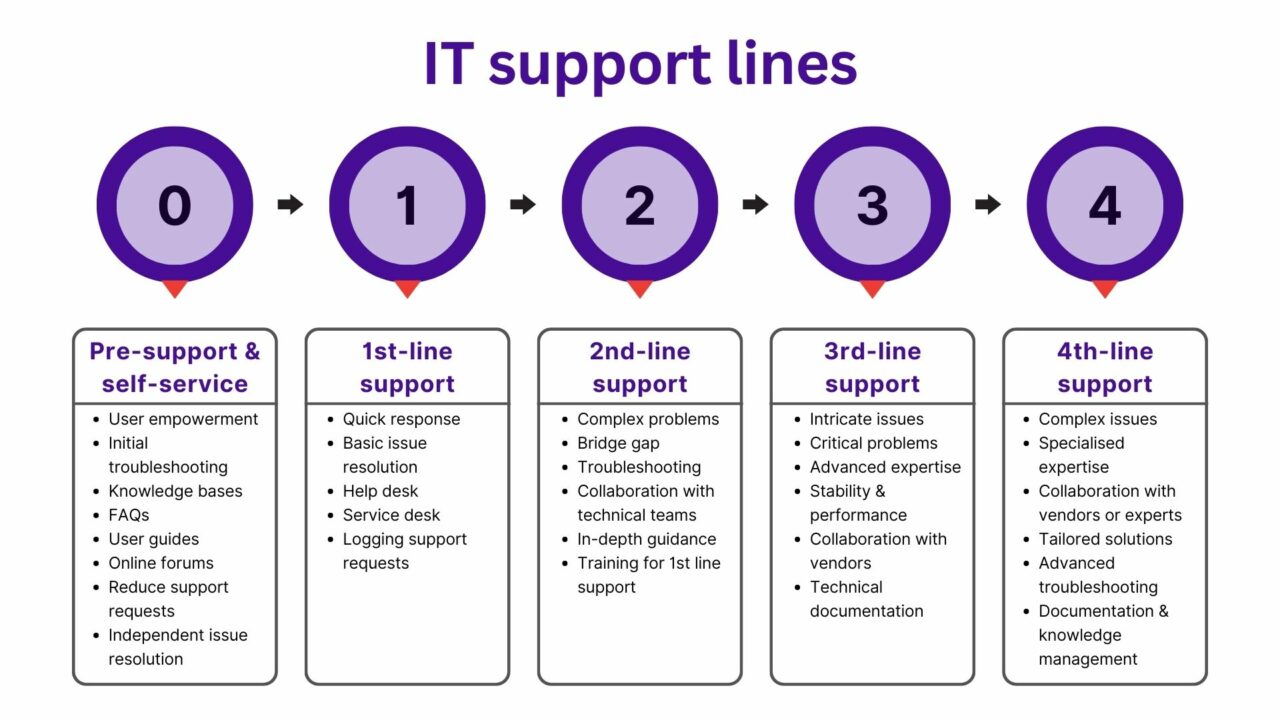In the fast-paced IT world, organisations rely heavily on IT support to ensure smooth operations and resolve technical issues promptly. However, not all IT support is the same. Different levels of support exist to cater to varying complexities of problems and provide effective solutions. This post explores the differences between 1st, 2nd, and 3rd line IT support levels. We also introduce the lesser-known 4th-line support level. Plus, we shed light on each level’s roles, responsibilities, and areas of expertise.
TL;DR
The different levels of IT support have specific roles in helping users and keeping the IT system running smoothly:
- 1st-line support provides fast response and resolves basic problems.
- 2nd-line support deals with more complex issues and acts as a connection between frontline support and specialised teams.
- 3rd-line support handles the most complex and significant problems, using advanced expertise to keep the IT infrastructure stable and performing well.
- 4th-line support handles the most complex and challenging technical issues, leveraging specialised expertise, collaborating with vendors and experts, and providing tailored solutions for effective problem resolution.
Understanding these differences helps organisations allocate resources effectively, provide efficient support, and increase productivity.
The big picture

Pre-support and self-service
Pre-support and self-service empower users to resolve common IT issues independently before contacting the support team.
Pre-support involves users performing initial troubleshooting using resources like knowledge bases and FAQs, while self-service provides users with tools and resources to address their IT needs independently. Both approaches aim to improve efficiency, reduce support requests, and increase user satisfaction.
1st-line support
1st-line support, also known as the help desk or service desk, is the initial point of contact for users seeking technical assistance. Their primary focus is providing immediate responses and basic troubleshooting to resolve common, straightforward issues.
Here are some key characteristics of 1st-line support:
Responsibilities
- Answering incoming calls, emails, and support tickets promptly
- Logging and categorising support requests
- Performing initial diagnostics to identify the nature of the problem
- Offering first-level troubleshooting steps to resolve simple issues
- Escalating complex problems to higher support levels, if necessary
- Maintaining clear and concise documentation of issues and resolutions
Skills and expertise
- Strong communication and customer service skills
- Good understanding of standard hardware and software issues
- Proficiency in remote support tools
- Familiarity with basic troubleshooting techniques
- Ability to work under pressure and manage multiple support requests simultaneously
Interestingly, there’s a growing demand for generative AI, like ChatGPT, to replace 1st-line support teams to increase efficiencies.
2nd-line support
2nd-line support acts as the bridge between 1st-line support and specialised technical teams. This support level involves more in-depth troubleshooting and problem-solving.
Here’s what you can expect from 2nd-line support:
Responsibilities
- Handling escalated support tickets from 1st line support
- Conducting thorough investigations and root cause analysis
- Diagnosing and resolving complex technical issues
- Providing in-depth guidance and training to 1st line support
- Collaborating with other technical teams for advanced problem resolution
- Maintaining detailed documentation for future reference
Skills and expertise
- Proficiency in a broader range of hardware and software systems
- Strong analytical and problem-solving skills
- Knowledge of network configurations and protocols
- Experience with advanced troubleshooting tools and techniques
- Ability to prioritise and manage critical issues effectively
3rd-line support
3rd-line support is the highest level of technical support within an organisation. These experts are responsible for resolving the most complex and critical issues that the lower support levels cannot address.
Here’s an overview of 3rd-line support:
Responsibilities
- Handling escalated issues from both 1st- and 2nd-line support
- Investigating and resolving advanced hardware and software problems
- Managing system upgrades, installations, and configurations
- Collaborating with vendors and external support for specialised expertise
- Developing and maintaining technical documentation and knowledge base
- Providing guidance and mentoring to lower-level support staff
Skills and expertise
- In-depth knowledge of complex IT systems and architectures
- Proficiency in multiple operating systems and programming languages
- Expertise in network infrastructure and security
- Familiarity with virtualisation technologies and cloud platforms
- Strong project management and leadership skills
4th-line support
4th line support involves engaging external vendors or experts to address highly complex or niche technical issues. It typically handles intricate system configurations, advanced software or hardware troubleshooting, and in-depth analysis of technical problems.
Responsibilities
- Handling complex issues: 4th-line support is responsible for tackling the most intricate and challenging technical issues that lower support levels cannot resolve.
- Providing specialised expertise: They offer advanced knowledge and expertise in specific technologies, software, or systems.
- Collaborating with vendors and experts: 4th-line support may work closely with product vendors, software developers, or subject matter experts to obtain specialised guidance and solutions.
- Conducting in-depth analysis: They perform comprehensive investigations and root cause analyses to identify the underlying causes of complex issues.
- Developing customised solutions: 4th-line support may create tailored solutions to address unique or uncommon technical problems.
- Creating and maintaining documentation: They document resolutions, best practices, and specialised knowledge for future reference and knowledge sharing.
Skills and expertise
- Expert technical knowledge: 4th-line support personnel possess extensive and in-depth knowledge of specific technologies, systems, or software.
- Strong analytical skills: They excel in analysing complex technical problems and identifying root causes.
- Problem-solving abilities: They can devise creative and effective solutions for intricate technical issues.
- Collaboration: They have experience collaborating with vendors and external experts to obtain specialised assistance.
- Advanced troubleshooting skills: They are adept at utilising advanced diagnostic tools and techniques to resolve complex issues.
The need to capture IT support lines in contracts
Capturing different IT support lines in contracts is vital as it defines responsibilities, sets service expectations, ensures continuity, facilitates resource allocation, aids vendor management, and provides legal protection for both parties.
Actions to take next
- Effectively capture your relationships with IT support providers by asking us to draft or review your IT professional services agreements.
- Manage the IT support service levels you expect from providers by asking us to draft or review your service level agreements.
- Worry less about managing the risks of IT providers by outsourcing your third-party risk assessments to our team.





